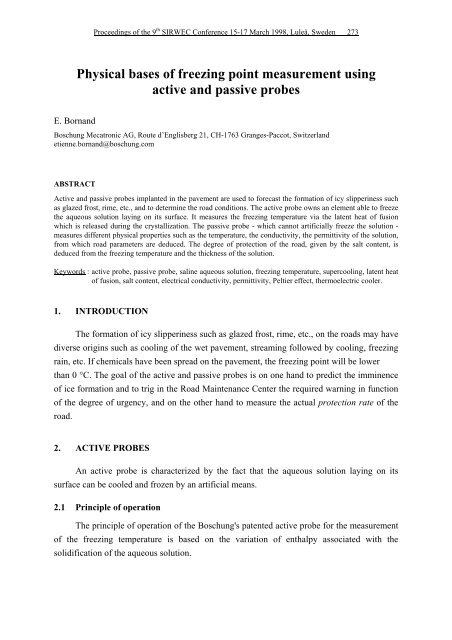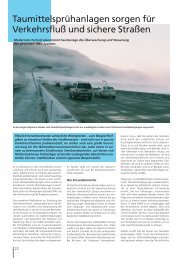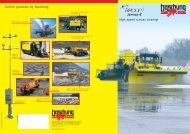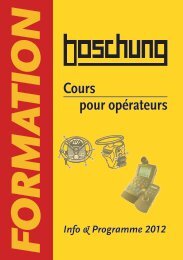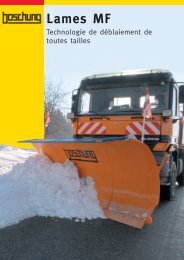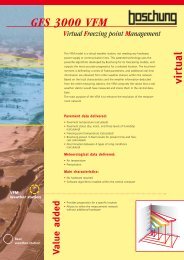Physical bases of freezing point measurement using ... - Boschung
Physical bases of freezing point measurement using ... - Boschung
Physical bases of freezing point measurement using ... - Boschung
You also want an ePaper? Increase the reach of your titles
YUMPU automatically turns print PDFs into web optimized ePapers that Google loves.
E. Bornand<br />
Proceedings <strong>of</strong> the 9 th SIRWEC Conference 15-17 March 1998, Luleå, Sweden 273<br />
<strong>Physical</strong> <strong>bases</strong> <strong>of</strong> <strong>freezing</strong> <strong>point</strong> <strong>measurement</strong> <strong>using</strong><br />
active and passive probes<br />
<strong>Boschung</strong> Mecatronic AG, Route d’Englisberg 21, CH-1763 Granges-Paccot, Switzerland<br />
etienne.bornand@boschung.com<br />
ABSTRACT<br />
Active and passive probes implanted in the pavement are used to forecast the formation <strong>of</strong> icy slipperiness such<br />
as glazed frost, rime, etc., and to determine the road conditions. The active probe owns an element able to freeze<br />
the aqueous solution laying on its surface. It measures the <strong>freezing</strong> temperature via the latent heat <strong>of</strong> fusion<br />
which is released during the crystallization. The passive probe - which cannot artificially freeze the solution -<br />
measures different physical properties such as the temperature, the conductivity, the permittivity <strong>of</strong> the solution,<br />
from which road parameters are deduced. The degree <strong>of</strong> protection <strong>of</strong> the road, given by the salt content, is<br />
deduced from the <strong>freezing</strong> temperature and the thickness <strong>of</strong> the solution.<br />
Keywords : active probe, passive probe, saline aqueous solution, <strong>freezing</strong> temperature, supercooling, latent heat<br />
<strong>of</strong> fusion, salt content, electrical conductivity, permittivity, Peltier effect, thermoelectric cooler.<br />
1. INTRODUCTION<br />
The formation <strong>of</strong> icy slipperiness such as glazed frost, rime, etc., on the roads may have<br />
diverse origins such as cooling <strong>of</strong> the wet pavement, streaming followed by cooling, <strong>freezing</strong><br />
rain, etc. If chemicals have been spread on the pavement, the <strong>freezing</strong> <strong>point</strong> will be lower<br />
than 0 °C. The goal <strong>of</strong> the active and passive probes is on one hand to predict the imminence<br />
<strong>of</strong> ice formation and to trig in the Road Maintenance Center the required warning in function<br />
<strong>of</strong> the degree <strong>of</strong> urgency, and on the other hand to measure the actual protection rate <strong>of</strong> the<br />
road.<br />
2. ACTIVE PROBES<br />
An active probe is characterized by the fact that the aqueous solution laying on its<br />
surface can be cooled and frozen by an artificial means.<br />
2.1 Principle <strong>of</strong> operation<br />
The principle <strong>of</strong> operation <strong>of</strong> the <strong>Boschung</strong>'s patented active probe for the <strong>measurement</strong><br />
<strong>of</strong> the <strong>freezing</strong> temperature is based on the variation <strong>of</strong> enthalpy associated with the<br />
solidification <strong>of</strong> the aqueous solution.
Proceedings <strong>of</strong> the 9 th SIRWEC Conference 15-17 March 1998, Luleå, Sweden 274<br />
2.1.1 Nucleation <strong>of</strong> ice<br />
Nine allotropic varieties <strong>of</strong> ice do exist, however only ice Ih exists under pressures<br />
lower than 200 MPa and temperatures greater than those <strong>of</strong> liquid air. It crystallizes in the<br />
hexagonal system (spatial group P 63/mmc) and is then the only ice that exists in the natural<br />
state.<br />
Ice may form either by the <strong>freezing</strong> <strong>of</strong> liquid water (producing for instance glazed frost)<br />
or by deposition from the vapor phase (producing for instance rime). In both cases, the<br />
initiation <strong>of</strong> the ice phase occurs by the nucleation <strong>of</strong> a small ice embryo. Under certain<br />
conditions, water can be cooled well below 0 °C and yet remains in the liquid state. Water in<br />
such a metastable state is said to be supercooled. If the nucleation <strong>of</strong> the ice phase occurs on<br />
foreign particles (impurities, dust particles, gaseous bubbles, etc.), the ice is said to form by<br />
heterogeneous nucleation. If foreign particles do not play a role in the nucleation, the ice<br />
phase must be initiated by water molecules combining together to form an ice embryo which<br />
can grow spontaneously. In this case, the ice is said to form by homogeneous nucleation. It is<br />
interesting to note that vibrations also initiate the crystallization <strong>of</strong> supercooled water. The<br />
nucleation <strong>of</strong> ice is discussed in detail in [Hobbs 1974].<br />
2.1.2 Latent heat <strong>of</strong> fusion<br />
The change in enthalpy dH associated with a change in phase <strong>of</strong> a material at constant<br />
pressure p is given by :<br />
dH = dU + pdV (1)<br />
where dU and dV are the changes in internal energy and volume <strong>of</strong> the material respectively.<br />
The latent heat <strong>of</strong> fusion Lf <strong>of</strong> ice is defined as the change in enthalpy when a unit mass <strong>of</strong> ice<br />
is converted isothermally and reversibly into liquid water. In this case, the term p dV is small<br />
compared to the other two terms in equation (1), so that Lf is equal to the change in internal<br />
energy. The latent heat <strong>of</strong> fusion <strong>of</strong> ice at 0 °C and standard atmospheric pressure is<br />
333.5 kJ/kg. For a discussion about this subject, see [Hobbs 1974].<br />
To melt ice, latent heat <strong>of</strong> fusion has to be supplied (endothermic transformation), while<br />
when water is frozen, an amount <strong>of</strong> heat equal to the latent heat <strong>of</strong> fusion is released<br />
(exothermic transformation).<br />
2.1.3 Scenario <strong>of</strong> the <strong>measurement</strong><br />
Instead <strong>of</strong> considering the cooling <strong>of</strong> pure water, let us consider first the behavior <strong>of</strong> a<br />
saline aqueous solution during cooling from an initial temperature T0, as illustrated in the<br />
figure 1. As <strong>point</strong>ed out by [Franks 1982], initially the solution supercools, until nucleation<br />
takes place at the temperature Tbc and crystal growth begins. Since the latent heat cannot be<br />
removed fast enough, the temperature rises to the melting temperature Tm. In the vicinity <strong>of</strong><br />
the growing ice crystals, the concentration <strong>of</strong> salt increases, reducing the local Tm, and
Proceedings <strong>of</strong> the 9 th SIRWEC Conference 15-17 March 1998, Luleå, Sweden 275<br />
therefore retarding further <strong>freezing</strong>. The accumulation <strong>of</strong> heat now being the limiting factor,<br />
ice continues to grow slowly at a constant rate. The temperature stays at Tm as far as the heat<br />
generation is greater or equal than the heat withdrawal. When the rate <strong>of</strong> cooling becomes<br />
greater than the rate <strong>of</strong> latent heat liberation, the temperature once again begins to fall. When<br />
all the water has frozen, the rate <strong>of</strong> cooling depends on the thermal conductivity <strong>of</strong> the<br />
solidified system. The temperature is then lowered until the asymptotic temperature Ta is<br />
reached.<br />
In the case <strong>of</strong> the cooling <strong>of</strong> pure water, the behavior is comparable to the one <strong>of</strong> an<br />
aqueous saline solution, with the differences that Tm will be precisely 0 °C and the <strong>freezing</strong><br />
will not be retarded by the phenomenon described above.<br />
The active probe achieves such a cooling and measures Tm by means <strong>of</strong> a thermocouple<br />
or a platinum RTD 1 . The cooling is stopped as soon as Tbc is reached. Note that in the rest <strong>of</strong><br />
the text, for reasons <strong>of</strong> more common usage in our field, Ts (temperature <strong>of</strong> solidification, or<br />
<strong>freezing</strong> <strong>point</strong> temperature 2 ) will be used instead <strong>of</strong> Tm.<br />
The shape <strong>of</strong> the cooling curve is the same whatever the deicing product my be, salt or<br />
deicers specially used on the airports such as ethylene glycol.<br />
supercooling<br />
T<br />
Tm<br />
T0<br />
T bc<br />
T a<br />
0<br />
beginning <strong>of</strong><br />
crystallization<br />
Figure 1 : behavior <strong>of</strong> a saline aqueous solution during cooling.<br />
2.2 Cooling performances<br />
The cooling <strong>of</strong> water at the surface <strong>of</strong> a probe, schematically represented in figure 2, is<br />
performed by a thermoelectric cooler (TEC). Heat is pumped through an metallic conductor<br />
and is rejected through a heat sink. The isolation between the cold and hot sides is achieved<br />
by an insulator. For the <strong>measurement</strong>s <strong>of</strong> cooling performances, as shown in the figure, the<br />
1 RTD = resistive temperature detector.<br />
2 In some documents, the <strong>freezing</strong> <strong>point</strong> temperature is named GT (Gefrier Temperatur).<br />
t
Proceedings <strong>of</strong> the 9 th SIRWEC Conference 15-17 March 1998, Luleå, Sweden 276<br />
temperature was measured at the center <strong>of</strong> the surface <strong>of</strong> the probe, i.e. at the bottom <strong>of</strong> the<br />
water, by a thermocouple.<br />
H2O<br />
Figure 2 : schematic representation <strong>of</strong> the cooling system.<br />
T<br />
thermocouple<br />
cooler<br />
body<br />
insulator (plastics)<br />
thermoelectric cooler<br />
heat sink<br />
Table 1 gives an example <strong>of</strong> computed cooling performances obtained with a<br />
commercial TEC. i is the current supplied to the TEC, U the voltage 3 , Qin the electric power,<br />
Qc the cooling power, Qh the rejected heating power and COP the coefficient <strong>of</strong> performance.<br />
Heat power and COP depend <strong>of</strong> course on the temperatures Tc and Th <strong>of</strong> the cold and hot sides<br />
<strong>of</strong> the TEC. In this example, Tc = - 19.1 °C and Th = 5.9 °C. The operation principle <strong>of</strong><br />
electronic refrigeration is described in Appendix A.<br />
i [A] U [V] Qin [W] Qc [W] Qh [W] COP<br />
1.5 1.4 2.1 1.7 3.8 0.80<br />
2 1.8 3.5 2.6 6.2 0.74<br />
2.5 2.1 5.3 3.4 8.7 0.63<br />
3 2.5 7.5 3.9 11.5 0.53<br />
3.3 2.7 9.0 4.2 13.2 0.47<br />
3.9 3.2 12.3 4.5 16.8 0.37<br />
Table 1 : cooling performances <strong>of</strong> a commercial TEC 4 .<br />
3 Note that the symbol U is used for the internal energy (§ 2.1.2) as well as for the voltage!<br />
4 MELCOR CP 1.0-31-05L.
Proceedings <strong>of</strong> the 9 th SIRWEC Conference 15-17 March 1998, Luleå, Sweden 277<br />
For the currents listed in table 1, <strong>measurement</strong>s <strong>of</strong> the cooling <strong>of</strong> pure water are shown<br />
in figure 3. The water thickness is 0.5 mm and its volume is about 80 mm 3 . As discussed in<br />
§ 2.1.3, the peaks <strong>of</strong> the curves originate from <strong>freezing</strong>. They reach the temperature <strong>of</strong> 0 °C.<br />
T [°C]<br />
10<br />
5<br />
0<br />
-5<br />
-10<br />
-15<br />
-20<br />
-25<br />
-30<br />
3.3 A<br />
3.9 A<br />
0 20 40 60 80 100 120 140 160 180<br />
t [s]<br />
1.5 A<br />
2 A<br />
Figure 3 : influence <strong>of</strong> the current on the cooling rate <strong>of</strong> pure water.<br />
2.5 A<br />
The times t-15 and t-20 necessary to lower the temperature <strong>of</strong> 15 °C, respectively 20 °C,<br />
are reported versus the current in figure 4, as well as the temperature difference between T0<br />
and Ta. With the low current <strong>of</strong> 1.5 A, cooling <strong>of</strong> more than 20 °C is reached. This means that<br />
even with low supplied power, effective cooling can be achieved.<br />
t [s]<br />
140<br />
120<br />
100<br />
80<br />
60<br />
40<br />
20<br />
0<br />
1 1.5 2 2.5 3 3.5 4<br />
i [A]<br />
Figure 4 : performances <strong>of</strong> cooling <strong>of</strong> the probe.<br />
34<br />
32<br />
30<br />
28<br />
26<br />
24<br />
22<br />
20<br />
T 0 - T a [°C]<br />
3 A<br />
t -15 [s]<br />
t -20 [s]<br />
T 0 - T a [°C]
Proceedings <strong>of</strong> the 9 th SIRWEC Conference 15-17 March 1998, Luleå, Sweden 278<br />
3. PASSIVE PROBES<br />
While active probes are able to artificially create solidification <strong>of</strong> an aqueous solution,<br />
passive one's do not. With this kind <strong>of</strong> probes, road conditions are deduced from<br />
<strong>measurement</strong>s <strong>of</strong> physical properties <strong>of</strong> the solution. The parameters which can be measured<br />
are the following 5 :<br />
3.1 Temperature<br />
The temperature <strong>of</strong> the pavement is measured by means <strong>of</strong> a thermocouple or a<br />
platinum RTD.<br />
3.2 Electrical properties<br />
The electrical properties which can be measured are the electrical conductivity σ and<br />
the permittivity (or dielectric constant) ε.<br />
To measure the electrical conductivity, the van der Pauw method [van der Pauw 1958]<br />
can be used.<br />
The permittivity <strong>of</strong> a material is given by :<br />
ε = ε0εr , (2)<br />
where ε0 = 8.85419 · 10 -12<br />
C V -1<br />
m -1<br />
is the permittivity <strong>of</strong> free space and εr the relative<br />
permittivity <strong>of</strong> the material. Dielectric and conduction properties may be investigated by<br />
measuring the impedance Z <strong>of</strong> the material as a function <strong>of</strong> the electrical frequency. εr is<br />
expressed by :<br />
εr( ω) = εr′ − iεr′′<br />
. (3)<br />
ω is the applied angular velocity <strong>of</strong> the electric signal and ε r ′ and εr ′′ are the real and<br />
complex parts <strong>of</strong> the relative permittivity 6 . The loss angle δ is :<br />
The electrical conductivity is connected to the permittivity by :<br />
εr<br />
tgδ<br />
=<br />
ε<br />
′′<br />
′ . (4)<br />
r<br />
σ = ω ε ε′′<br />
. (5)<br />
Water is a polar material, i.e. constituted by dipoles. At low frequencies, its<br />
permittivity ε r ′ can be greater than 100. The electrical properties <strong>of</strong> liquid water are discussed<br />
5 None exhaustive list.<br />
6<br />
εr ′ is a measure <strong>of</strong> how much energy is stored in the material and εr ′′ a measure <strong>of</strong> how much energy is lost.<br />
0 r
Proceedings <strong>of</strong> the 9 th SIRWEC Conference 15-17 March 1998, Luleå, Sweden 279<br />
in [Franks 1972], those <strong>of</strong> pure ice in [Hobbs 1974, Jaccard 1959, Ruepp 1973, Franks 1982]<br />
and those <strong>of</strong> aqueous electrolyte solutions in [Horvath 1985, Franks 1973]. Data are given in<br />
[Zaytsev and Aseyev 1992, Barthel et al. 1995].<br />
4. DISCUSSION<br />
4.1 Utilization <strong>of</strong> active and passive probes<br />
As we have seen, the first goal <strong>of</strong> the active probe is to measure the <strong>freezing</strong><br />
temperature. However it allows also to measure the surface temperature Tr <strong>of</strong> the road. In that<br />
case, stabilization between cycles would have to be performed. It is interesting to note that the<br />
surface temperature <strong>of</strong> the road could be difficult to measure with only one probe. As shown<br />
by Scharsching [Scharsching 1991] its value is not homogeneous on all the surface <strong>of</strong> the<br />
road. The location <strong>of</strong> the probe has to be chosen with care.<br />
It is also possible to use in the same vicinity all together an active an a passive probe,<br />
the first one measuring Ts and the second one 7 Tr. The last possible configuration is to use<br />
only a passive probe, in conjunction with meteorological sensors (relative humidity,<br />
precipitation, etc.).<br />
4.2 Salt content<br />
For the road's winter maintenance executive, the knowledge <strong>of</strong> the <strong>freezing</strong> temperature,<br />
as important it could be, is nevertheless not sufficient. Due to precipitation, streaming or<br />
evaporation, the amount <strong>of</strong> water on the pavement, and then the concentration <strong>of</strong> chemical<br />
and the <strong>freezing</strong> temperature, may vary. The parameter which can be used to characterize the<br />
protection rate <strong>of</strong> the road is the salt content. As it will be shown, it can be deduced from the<br />
<strong>freezing</strong> temperature and the thickness <strong>of</strong> the solution. The example <strong>of</strong> spreading solid<br />
sodium chloride as anti-icing treatment will be considered.<br />
The quantity <strong>of</strong> salt spread by the service vehicle can be chosen to give a salt content s<br />
comprised between 5 and 40 g/m 2 . After the salting, the mass mNaCl <strong>of</strong> salt laying on an area A<br />
<strong>of</strong> the pavement is given by :<br />
m = s⋅<br />
A . (6)<br />
NaCl<br />
If salt is diluted in a certain amount mH 2 O <strong>of</strong> water (in order <strong>of</strong> simplification, the salt<br />
content on the area A is kept constant), the weight concentration c <strong>of</strong> NaCl will be :<br />
mNaCl<br />
c =<br />
m + m<br />
NaCl H2O m<br />
=<br />
m<br />
NaCl<br />
tot<br />
, (7)<br />
7 The passive probe has to be placed far enough from the active one in order to be not influenced by it.
Proceedings <strong>of</strong> the 9 th SIRWEC Conference 15-17 March 1998, Luleå, Sweden 280<br />
with m = m + m .<br />
tot NaCl H2O The volumetric properties <strong>of</strong> aqueous sodium chloride solutions are for instance given<br />
in [Rogers and Pitzer 1982]. For temperatures close to 0 °C, the specific volume ν (in cm 3 /g)<br />
can be fitted by :<br />
2<br />
ν( c) = 0. 653c − 0. 704 c+<br />
0. 999<br />
It is then possible to compute the thickness e <strong>of</strong> the solution :<br />
e =<br />
c ⋅ m<br />
A<br />
. (8)<br />
ν( ) tot . (9)<br />
It remains to express the <strong>freezing</strong> temperature Ts corresponding to the considered salt<br />
concentration. Ts is <strong>of</strong> course given by the phase diagram <strong>of</strong> the NaCl - H2O mixture [Zaytsev<br />
and Aseyev 1992] represented in figure 5.<br />
T s [°C]<br />
0<br />
-5<br />
-10<br />
-15<br />
-20<br />
-25<br />
c<br />
0 0.05 0.1 0.15 0.2 0.25 0.3<br />
Figure 5 : NaCl - H2O phase diagram. Eutectic coordinates are ceutectic = 0.2331<br />
and Ts min = -21.12 °C.<br />
In order to compute the <strong>freezing</strong> temperature, the curves have been fitted. The one with<br />
negative slope (c ∈ [0, 0.2331]) is approximated by the following polynomial :<br />
3 2<br />
T ( c) =−470. 65c −32. 625c −57.<br />
232 c<br />
s<br />
while the one with positive slope (c ∈ [0.2331, 0.266]) is approximated by :<br />
, (10)<br />
3 2<br />
Ts( c) =− 531, 791c + 393, 483c − 96, 251c+ 7, 770. 5 . (11)
Proceedings <strong>of</strong> the 9 th SIRWEC Conference 15-17 March 1998, Luleå, Sweden 281<br />
Let us consider now a road where a salt content <strong>of</strong> 20 g/m 2 has been spread. Table 2<br />
gives the <strong>freezing</strong> temperatures for different thicknesses <strong>of</strong> the solution. From -13.9 °C for a<br />
thickness <strong>of</strong> 0.1 mm, the <strong>freezing</strong> temperature increases very quickly to -2.3 °C for a<br />
thickness <strong>of</strong> 0.5 mm!<br />
e [mm] Ts [°C]<br />
0.1 -13.9<br />
0.2 -6.1<br />
0.3 -3.9<br />
0.4 -2.9<br />
0.5 -2.3<br />
Table 2 : dependence <strong>of</strong> the <strong>freezing</strong> temperature on the thickness <strong>of</strong> the solution<br />
for a salt content <strong>of</strong> 20 g/m 2 .<br />
Freezing temperatures are reported versus the thickness <strong>of</strong> the solution for different salt<br />
contents in figure 6. When e increases, the phase diagram <strong>of</strong> figure 5 is gone through from the<br />
right to the left, or in other words, in the direction <strong>of</strong> decreasing NaCl concentrations.<br />
T s [°C]<br />
0<br />
-5<br />
-10<br />
-15<br />
-20<br />
-25<br />
5 g/m 2<br />
e [mm]<br />
0.0 0.2 0.4 0.6 0.8 1.0 1.2 1.4<br />
10 g/m 2<br />
20 g/m2<br />
30 g/m 2<br />
40 g/m 2<br />
Figure 6 : dependence <strong>of</strong> Ts on the thickness <strong>of</strong> the solution for different salt contents.<br />
For a given salt constant, the thickness eopt <strong>of</strong> the solutions which gives the best<br />
protection <strong>of</strong> the road, i.e. the NaCl concentration <strong>of</strong> the eutectic, is given by :<br />
e<br />
opt [mm]<br />
ν ( 0. 233)<br />
⋅ s<br />
-3<br />
=<br />
= 3.73⋅10 s 2 . (12)<br />
[ g/m ] 0. 233
Proceedings <strong>of</strong> the 9 th SIRWEC Conference 15-17 March 1998, Luleå, Sweden 282<br />
eopt , which is rather weak, is represented in figure 7.<br />
e opt [mm]<br />
0.16<br />
0.14<br />
0.12<br />
0.10<br />
0.08<br />
0.06<br />
0.04<br />
0.02<br />
0.00<br />
Figure 7 : dependence <strong>of</strong> eopt on s.<br />
0 10 20 30 40<br />
s [g/m 2 ]<br />
Knowing e and Ts, the salt content can be calculated by :<br />
cT ( s)<br />
⋅ e<br />
s =<br />
ν<br />
( cT ( ) )<br />
where c(Ts) is approximated by the following polynomial :<br />
s<br />
, (13)<br />
−63−42−2 cT ( ) =−6. 211⋅10 ⋅T −4. 637 ⋅10 ⋅T −1807 . ⋅10 ⋅T<br />
s s s<br />
4.3 Accuracy <strong>of</strong> the <strong>measurement</strong> <strong>of</strong> the <strong>freezing</strong> temperature<br />
s<br />
. (14)<br />
While the accuracy <strong>of</strong> the <strong>measurement</strong> <strong>of</strong> Ts by an active probe is mostly given by the<br />
accuracy ΔT <strong>of</strong> the sensor which measures the temperature during the cooling, the one <strong>of</strong> a<br />
passive probe is dependent <strong>of</strong> the function T = T( x , x , x , K, x , K , x ) used to compute<br />
s s 1 2 3 i n<br />
the <strong>freezing</strong> temperature. In that case, the absolute error is given by :<br />
ΔT<br />
s ≅<br />
i=<br />
1<br />
n<br />
Ts<br />
∑ x<br />
∂<br />
∂<br />
i<br />
Δ x , (15)<br />
where the xi are the different variables which are measured and Δxi their absolute errors. In<br />
other words, the accuracy <strong>of</strong> a passive probe is a sum <strong>of</strong> errors depending <strong>of</strong> the different<br />
parameters themselves and their absolute error. If for instance a passive probe is able to<br />
measure the salt concentration and the thickness <strong>of</strong> the solution, it can be understood that<br />
errors on c and e (due to the <strong>measurement</strong>s themselves, pollutants, etc.) will affect the<br />
i
Proceedings <strong>of</strong> the 9 th SIRWEC Conference 15-17 March 1998, Luleå, Sweden 283<br />
computation (13) <strong>of</strong> the salt content. Therefore it comes that the accuracy <strong>of</strong> active probes is<br />
better than that <strong>of</strong> passive ones.<br />
5. CONCLUSION<br />
The physical principles <strong>of</strong> the <strong>freezing</strong> <strong>point</strong> <strong>measurement</strong> by active and passive probes<br />
have been discussed. Whatever the deicing product may be (NaCl, CaCl2, MgCl2, ethylene<br />
glycol, etc.), the active probe measures truly Ts, with a good accuracy. The <strong>measurement</strong> <strong>of</strong><br />
this same parameter with a passive probe is less accurate. In addition, this kind <strong>of</strong> probe<br />
requires parametrizations <strong>of</strong> the s<strong>of</strong>tware and can require the use <strong>of</strong> meteorological data. By<br />
contrast, the passive probe is cheaper than the active one.<br />
ACKNOWLEDGMENTS<br />
The author would like to thank J. Heierli for helpful discussions and P. Francey for<br />
performing the <strong>measurement</strong>s <strong>of</strong> the cooling performances <strong>of</strong> the probe.
Proceedings <strong>of</strong> the 9 th SIRWEC Conference 15-17 March 1998, Luleå, Sweden 284<br />
Appendix A - Peltier cooling<br />
In the active probe, the <strong>freezing</strong> <strong>of</strong> the solution is artificially created by a TEC, which is<br />
a solid state heat pump that utilizes the Peltier effect. It consists <strong>of</strong> a number <strong>of</strong> p- and n-types<br />
pairs (couples) <strong>of</strong> a semiconductor material 8 [Goldsmid 1986] connected electrically in series<br />
and sandwiched between two ceramic plates, i.e. connected thermally in parallel. As shown<br />
schematically in figure A.1, when powered by a DC power supply, current i causes heat to<br />
move from one side <strong>of</strong> the TEC to the other. This creates <strong>of</strong> course a cold side and a hot side 9 .<br />
The rejected heating power Qh, greater than the heat Qc pumped in the cold side, is given by :<br />
Qh = Qc + Qin = Qc + U ⋅ i . (A1)<br />
Tc and Th are the temperatures <strong>of</strong> the cold and hod side <strong>of</strong> the TEC.<br />
U<br />
i<br />
TEC<br />
Figure A1 : schematic representation <strong>of</strong> the principle <strong>of</strong> the Peltier pumping.<br />
Qc does not increase linearly with the current. The yield <strong>of</strong> the TEC is defined by the<br />
coefficient <strong>of</strong> performance (COP) :<br />
Qc<br />
Qc<br />
COP = =<br />
Q U ⋅i<br />
in<br />
Qc<br />
Qh<br />
Tc<br />
Th<br />
. (A2)<br />
For the same TEC and temperatures Tc and Th than those considered in § 2.2, figure A2<br />
shows the COP versus the current. The current giving the maximum coefficient <strong>of</strong><br />
performance COPmax is named the optimal current iopt.<br />
8 The best semiconductor for thermoelectric refrigeration at ordinary temperatures is bismuth telluride, Bi2Te3.<br />
9 If the direction <strong>of</strong> the current is inverted, the cold and hot sides are also inverted. It is then possible to cool or<br />
to heat the solution at the surface <strong>of</strong> the probe.
REFERENCES<br />
Proceedings <strong>of</strong> the 9 th SIRWEC Conference 15-17 March 1998, Luleå, Sweden 285<br />
COP<br />
1.0<br />
0.8<br />
0.6<br />
0.4<br />
0.2<br />
0.0<br />
0 0.5 1 1.5 2 2.5 3 3.5 4<br />
i [A]<br />
Figure A2 : dependence <strong>of</strong> COP on current for a commercial TEC 10 ,<br />
Tc = - 19.1 °C and Th = 5.9 °C. Coordinates <strong>of</strong> the maximum are<br />
(iopt = 1.52 A, COPmax = 0.805).<br />
Barthel, J., Buchner, R., and Münsterer, M., 1995, Electrolyte Data Collection - Part 2 :<br />
Dielectric Properties <strong>of</strong> Water and Aqueous Electrolyte Solutions, DECHEMA.<br />
Franks, F. (ed.), 1972, Water - A Comprehensive Treatise, Vol. 1 : The Physics and <strong>Physical</strong><br />
Chemistry <strong>of</strong> Water, Plenum Press.<br />
Franks, F. (ed.), 1973, Water - A Comprehensive Treatise, Vol. 3 : Aqueous Solutions <strong>of</strong><br />
Simple Electrolytes, Plenum Press.<br />
Franks, F. (ed.), 1982, Water - A Comprehensive Treatise, Vol. 7 : Water and Aqueous<br />
Solutions at Subzero Temperatures, Plenum Press.<br />
Goldsmid, H. J., 1986, Electronic Refrigeration, Pion Limited.<br />
Hobbs, P. V., 1974, Ice Physics, Clarendon Press.<br />
Horvath, A. L., 1985, Handbook <strong>of</strong> Aqueous Electrolyte Solutions : <strong>Physical</strong> Properties,<br />
Estimation and Correlation Methods, Ellis Horwood Limited.<br />
Jaccard, C., 1959, Etude théorique et expérimentale des propriétés électriques de la glace,<br />
Diss. Naturwiss. ETH Zürich Nr. 2871, Helv. Phys. Acta 32 (2), 88-129.<br />
Rogers, P. S. Z., and Pitzer, K. S., 1982, Volumetric Properties <strong>of</strong> Aqueous Sodium Chloride<br />
Solutions, Journal <strong>of</strong> <strong>Physical</strong> and Chemical Reference Data 11 (1), 15-81.<br />
Ruepp, R., 1973, Electrical Properties <strong>of</strong> Ice Ih Single Crystals, in Whalley, E., Jones, S. J.<br />
and Gold, L. W. (eds), Physics and Chemistry <strong>of</strong> Ice, Royal Society <strong>of</strong> Canada, Proc. <strong>of</strong><br />
the Fourth International Symposium on the Physics and Chemistry <strong>of</strong> Ice, Ottawa,<br />
August 14-18, 1972, 179-86.<br />
10 MELCOR CP 1.0-31-05L.
Proceedings <strong>of</strong> the 9 th SIRWEC Conference 15-17 March 1998, Luleå, Sweden 286<br />
Scharsching, H., 1991, FV 3051 Glatteisfrühwarnsysteme Test 1990/91, Schlussbericht,<br />
Strassenforschungsauftrag des Bundesministeriums für wirtschaftliche<br />
Angelegenheiten.<br />
van der Pauw, L. J., 1958, A Method <strong>of</strong> Measuring Specific Resistivity and Hall Effect <strong>of</strong><br />
Discs <strong>of</strong> Arbitrary Shape, Philips Res. Rep. 13, 1-9.<br />
Zaytsev I. D., and Aseyev, G. G. (eds), 1992, Properties <strong>of</strong> Aqueous Solutions <strong>of</strong> Electrolytes,<br />
CRC Press.


